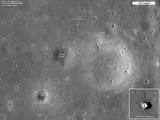
 Subtly Shaded Map of Moon Reveals Titanium Treasure Trove —
Subtly Shaded Map of Moon Reveals Titanium Treasure Trove —
A map of the Moon combining observations in visible and ultraviolet wavelengths shows a treasure trove of areas rich in titanium ore. Not only is titanium an extremely valuable element (a metal used extensively in aircraft due to its strength and light weight), it is key to helping scientists unravel the mysteries of the Moon’s interior.
“Looking up at the Moon, its surface appears painted with shades of grey—at least to the human eye. But with the right instruments, the Moon can appear colorful,” said Arizona State University’s Mark Robinson “The maria appear reddish in some places and blue in others. Although subtle, these color variations tell us important things about the chemistry and evolution of the lunar surface. They indicate the titanium and iron abundance, as well as the maturity of a lunar soil.”
The Lunar Reconnaissance Orbiter’s Wide Angle Camera is imaging the Moon’s surface from lunar orbit in seven different wavelengths. Specific minerals strongly reflect or absorb certain parts of the electromagnetic spectrum, so the wavelengths detected by this instrument help scientists better understand the chemical composition of the lunar surface.
The multi-wavelength mapping technique also shed light on how space weather changes the lunar surface. Over time, the lunar surface materials are altered by the impact of charged particles from the solar wind and high-velocity micrometeorite impacts. Together these processes work to pulverize rock into a fine powder and alter the surface’s chemical composition and hence its color. Recently exposed rocks, such as the rays that are thrown out around impact craters, appear bluer and have higher reflectance than more mature soil. Over time this “young” material darkens and reddens, disappearing into the background after about 500 million years.
COMPARISON WITH MOON-ROCK SAMPLES
Robinson and his team previously developed a technique using Hubble Space Telescope images to map titanium abundances around a small area centered on the Apollo 17 landing site. Samples around the site spanned a broad range of titanium levels. By comparing the titanium in the Apollo moon-rock samples with the Hubble images, the team found that the measured titanium levels corresponded to the ratio of ultraviolet to visible light reflected by the lunar soils—the more titanium, the more ultraviolet was reflected.
The highest titanium abundances in similar kinds of rocks on Earth are around one percent or less. The new map shows that in the Moon’s maria (the dark areas called ‘seas’), titanium abundances range from about one percent to a little more than ten percent.
“We still don’t really understand why we find much higher abundances of titanium on the Moon compared to similar types of rocks on Earth,” said Robinson. “What the lunar-titanium richness does tell us is something about the conditions inside the Moon shortly after it formed, knowledge that geochemists value for understanding the evolution of the Moon.”
Lunar titanium is mostly found in the mineral ilmenite, a compound containing iron, titanium and oxygen. Future miners living and working on the Moon could break down ilmenite to liberate these elements.
“The new map is a valuable tool for lunar exploration planning,” said Robinson. “Astronauts will want to visit places with both high scientific value and a high potential for resources that can be used to support exploration activities. Areas with high titanium provide both—a pathway to understanding the interior of the Moon and potential mining resources.”
You can contact Bob Eklund at [email protected], or visit his websites at www.bobeklund.com and http://firststarbook.com.


Be the first to comment